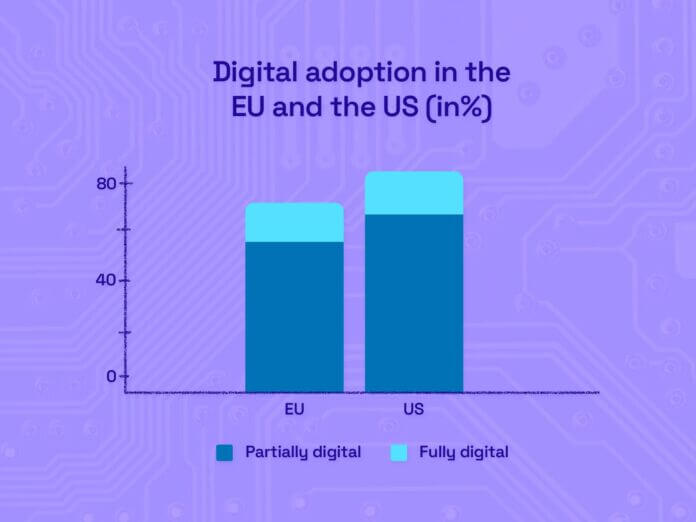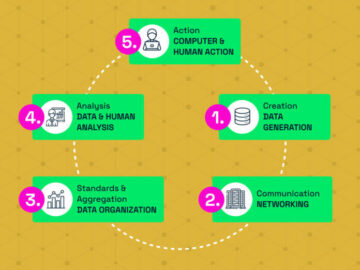
Despite persuasive evidence of the benefits of digital transformation, many manufacturers are still hesitant about IoT adoption. The primary reason is that it looks like a heavy lift for them, in terms of cost, effort, and possible disruption.
This fear stops them from automating their processes and bringing smart technologies to their production environments. Thus, a lot of IoT initiatives crash against an insurmountable number of presumed challenges.
In reality, the challenges relate to the integration with third-party platforms and retraining management staff. In other words, the main barrier on the way to IoT adoption in manufacturing is the lack of understanding about the available solutions and the importance of smart technologies for production growth.
Some companies give up without trying or simply choose technologies that are neither suitable nor valuable for their business. However, the positive news is that collaboration and data exchange in the industry will enable progress.
Manufacturers must connect many different systems and transfer the corresponding knowledge to meet modern requirements for lower operations costs and speed to market. Those who embrace the adoption of smart technologies for a variety of manufacturing use cases can successfully gain a competitive edge.
Wired, On-premises Solutions
The use of cloud technologies in manufacturing is another educational opportunity. Today, some manufacturing companies don’t trust wireless communications.
They are skeptical about everything related to cloud-based solutions and prefer to rely on isolated networks with on-premises servers and wired data transfers. This comes from a legitimate fear of production interruption and real revenue loss.
Overcoming the Fear of IoT Adoption
The most straightforward way to bring automation and smart technologies to manufacturing is through education and proof of value. Customers are open to new technologies when they solve a problem, reduce costs, or provide a way to speed production and efficiency.
If the suggested solution is a “nice to have,” then it will be challenging to persuade a company to implement it. If, on the other hand, competitors are leveraging these same technologies to gain a market advantage, the fear of the unknown quickly gives way to legitimate curiosity and a willingness to listen.
It is crucial to provide manufacturers with proven implementations of IoT technology and viable problem-solving options through customer references and examples. This not only shortens the timeline for digital transformation but also prepares them for any challenges.
Seeing demonstrated outcomes from peers in their spaces can empower companies and enable them to move forward more rapidly with management approvals for IoT implementations.
Other Factors Influencing Decision-Making
COVID-19 brought changes to the manufacturing industry. In particular, the pandemic shifted the buyer persona on the customer side, making it more complex for IoT vendors to approach.
Because of supply chain issues and labor shortages, the entire C-Suite became intimately involved in floor-level issues and decisions. This resulted in an increased number of stakeholders and a more complex and lengthened process for change.
This new and increased set of buyers means that IoT technology providers need to articulate the benefits of IoT solutions to a broader set of influencers across departments and functions within each company.
Despite the increased interest and demand for smart technologies in the market, the decision-making process became slower as multiple stakeholders needed to understand the risks, agree on projected value benefits, and weigh these against other company initiatives.
Significant losses from the unexpected consequences of the pandemic made industrial companies rethink their current approach to business. With that came a desire to be more resilient to such kind of force-majeure circumstances, by optimizing existing processes and minimizing their dependence on external conditions. These tendencies play well for IoT implementations, which can bring some of these efficiencies.
Commitments toward sustainability goals towards 2030 are another driving factor towards factory modernization. New IoT technologies can reduce energy use and carbon emissions when deployed across both manufacturing sites and their associated supporting offices.
These upgrades consist of a mix of upgrading existing facilities and building new, modern, energy-efficient ones. The focus on sustainability can become a driving force for the wider adoption of IoT technologies and make the manufacturing industry smarter, more efficient, and sustainable, as well as improve the well-being of its employees.
U.S. vs. European Market
The rate of adoption of digital technologies and cloud solutions also varies geographically. The leading position in this category is still occupied by U.S. firms.
According to the European Investment Bank (EIB) Investment Report 2019/2020, EU firms are less likely to innovate or adopt new technologies than US firms. Only 66 percent of manufacturing firms in the European Union, compared to 78 percent in the United States, report having adopted at least one digital technology.
Using data on specific digital technologies in the four sectors suggests that this gap is driven by lower adoption rates of the Internet of Things (IoT) technologies.
According to the EIB Investment Report 2022/2023, the COVID-19 crisis made European firms change their vector for digitalization. More than half of EU firms (53 percent) said they took steps to become more digital, for example, by providing services online.
Note: The figure is based on a survey asking firms to answer questions on four different digital technologies: whether they have heard about them, not heard about them, implemented them in parts of their business, or whether their entire business is organized around them.
A firm is identified as “partially digital” if at least one digital technology was implemented in parts of the business, and “fully digital” if the entire business is organized around at least one digital technology. Firms are weighted using value added.
Note: The number over the bars indicates differences in percentage points between the United States and the European Union.
While European firms made big gains, the share of firms that invested in digitalization as a response to the pandemic was still higher in the United States. This gap is driven by greater U.S. investment in machinery and equipment and innovation, particularly in information and communication technology equipment and intellectual property.
The European Union, however, has been closing the gap with the United States on the adoption of advanced digital technologies over the past four years. 69 percent of EU firms implemented advanced digital technologies in 2022, compared with 71 percent in the United States.
The Benefits of Smart Technology
The most obvious benefits of the adoption of smart technologies for manufacturers are the achievement of sustainability goals, reduction of energy costs, increased operational efficiencies, and greater throughput and profitability.
Based on the accurate data from connected devices, manufacturers can review every production process to analyze, recalibrate, and optimize it. They can easily identify energy savings and reduce untapped resources, thus increasing revenues and opening new growth opportunities.
For industrial companies just starting their digital transformation journey, the best place to begin is to understand how IoT technologies can transform their operations:
- Reduced costs and downtime: Data from sensors and edge devices allows operators and engineers to detect improper behavior of the equipment and prevent its failures (preventive maintenance instead of time-consuming repairs). This enables them to upgrade the existing critical assets rather than invest efforts, time, and money in additional digital and physical resources. Moreover, tracking spare parts and materials significantly facilitates supply management, which also contributes to enhancing efficiency and uptime.
- Minimized gaps between planned and actual production results: Optimized production processes, increased uptime, and proper management help speed production without delays.
- Improved quality of the final products: Reducing downtime and maintenance costs allows manufacturers to focus on more sophisticated tasks, including products. This looks even more feasible with smart technologies since automated and controllable processes minimize the risks of human errors.
- Centralized data analysis: With intelligent data collection and management, it’s possible to organize a common knowledge base and data storage across the factory and multiple locations by leveraging cloud technologies.
Additional Value Through Partnership
Integration with third-party systems for extended functionality, or partnership networks, provides additional value for clients and is essential to creating a smart manufacturing facility.
For example, if a company has a BMS system in place, it can integrate additional building IoT technologies and other systems that could include security, air quality, or crisis management. Being BMS vendor agnostic is important, as many manufacturers leverage different systems in different locations.
Adoption of Smart Technologies
The decision-making process for adopting smart technologies in manufacturing is influenced by various factors. The challenges of cost, effort, and potential disruption often deter manufacturers from embracing IoT adoption, but education and proof of value can help overcome these fears.
The preference for on-premises solutions and the perception of wireless networks as insecure also play a role in decision-making, but advancements in cloud technologies, edge computing, and network security can address these concerns.
The COVID-19 pandemic has led to a more complex decision-making landscape, with multiple stakeholders and a focus on resilience and sustainability.
Convincing these new influencers of the benefits of smart technologies: achieving sustainability goals, reducing energy costs, increasing operational efficiencies, and improving product quality will be key for the manufacturing industry to embrace the use of IoT technologies. Those who make the move sooner rather than later will gain an early mover advantage and a competitive edge.
This article was created based on a personal interview with Stefan Schwab, the CEO of Enlighted.
- SEO Powered Content & PR Distribution. Get Amplified Today.
- PlatoData.Network Vertical Generative Ai. Empower Yourself. Access Here.
- PlatoAiStream. Web3 Intelligence. Knowledge Amplified. Access Here.
- PlatoESG. Automotive / EVs, Carbon, CleanTech, Energy, Environment, Solar, Waste Management. Access Here.
- PlatoHealth. Biotech and Clinical Trials Intelligence. Access Here.
- ChartPrime. Elevate your Trading Game with ChartPrime. Access Here.
- BlockOffsets. Modernizing Environmental Offset Ownership. Access Here.
- Source: https://www.iotforall.com/the-adoption-of-smart-technologies-in-manufacturing
- :has
- :is
- :not
- $UP
- 1
- 2022
- 2030
- 66
- a
- About
- accurate
- achievement
- achieving
- across
- actual
- added
- Additional
- address
- adopt
- adopted
- Adopting
- Adoption
- advanced
- advancements
- ADvantage
- against
- AIR
- allows
- also
- an
- analyze
- and
- Another
- answer
- any
- approach
- approvals
- ARE
- around
- article
- articulate
- AS
- asking
- Assets
- associated
- At
- Automated
- automating
- Automation
- available
- Bank
- barrier
- bars
- base
- based
- BE
- became
- become
- been
- begin
- behavior
- being
- benefits
- BEST
- between
- Big
- both
- bring
- Bringing
- broader
- brought
- Building
- business
- but
- BUYER..
- buyers
- by
- C-suite
- came
- CAN
- carbon
- carbon emissions
- cases
- Category
- ceo
- chain
- challenges
- challenging
- change
- Changes
- Choose
- circumstances
- clients
- closing
- Cloud
- collaboration
- collection
- comes
- Common
- Communication
- Communications
- Companies
- company
- compared
- competitive
- competitors
- complex
- computing
- Concerns
- conditions
- Connect
- connected
- connected devices
- Consequences
- contributes
- Corresponding
- Cost
- Costs
- could
- COVID-19
- COVID-19 Crisis
- COVID-19 pandemic
- Crash
- created
- Creating
- crisis
- critical
- crucial
- curiosity
- Current
- customer
- Customers
- data
- Data Exchange
- data storage
- Decision Making
- decisions
- delays
- Demand
- demonstrated
- departments
- dependence
- deployed
- desire
- detect
- Devices
- differences
- different
- digital
- digital technologies
- digital technology
- Digital Transformation
- digitalization
- Disruption
- Dont
- downtime
- driven
- driving
- each
- Early
- easily
- Edge
- edge computing
- Education
- educational
- efficiencies
- efficiency
- efficient
- effort
- efforts
- embrace
- embracing
- Emissions
- employees
- empower
- enable
- enables
- energy
- energy use
- Engineers
- enhancing
- Entire
- environments
- equipment
- Errors
- essential
- EU
- European
- european union
- Even
- Every
- everything
- evidence
- example
- examples
- exchange
- existing
- external
- facilitates
- facilities
- Facility
- factor
- factors
- factory
- fear
- fears
- feasible
- Figure
- final
- Firm
- firms
- Focus
- For
- Force
- Forward
- four
- from
- functionality
- functions
- Gain
- Gains
- gap
- gaps
- Give
- gives
- Goals
- greater
- Growth
- Half
- hand
- Have
- having
- heard
- heavy
- help
- Hesitant
- higher
- How
- However
- HTTPS
- human
- identified
- identify
- if
- implement
- implementations
- implemented
- importance
- important
- improve
- improving
- in
- In other
- include
- Including
- increased
- increasing
- indicates
- industrial
- industry
- influenced
- influencers
- influencing
- information
- initiatives
- innovate
- Innovation
- insecure
- instead
- integrate
- integration
- intellectual
- intellectual property
- Intelligent
- interest
- Internet
- internet of things
- Interview
- Invest
- invested
- investment
- involved
- iot
- isolated
- issues
- IT
- ITS
- journey
- jpg
- just
- Key
- Kind
- knowledge
- labor
- Lack
- landscape
- later
- leading
- least
- Led
- legitimate
- less
- Leverage
- leveraging
- like
- likely
- locations
- LOOKS
- loss
- losses
- Lot
- lower
- machinery
- made
- Main
- maintenance
- make
- Making
- management
- Manufacturers
- manufacturing
- manufacturing industry
- many
- Market
- materials
- max-width
- means
- Meet
- minimize
- minimizing
- mix
- Modern
- modernization
- money
- more
- more efficient
- Moreover
- most
- move
- move forward
- multiple
- must
- Need
- needed
- Neither
- network
- Network Security
- networks
- New
- New technologies
- news
- nor
- number
- obvious
- of
- offices
- often
- on
- ONE
- ones
- online
- only
- open
- opening
- operational
- Operations
- operators
- opportunities
- Opportunity
- Optimize
- optimized
- optimizing
- Options
- or
- Organized
- Other
- outcomes
- over
- Overcome
- pandemic
- particular
- particularly
- Partnership
- parts
- past
- peers
- percent
- percentage
- perception
- personal
- physical
- Place
- planned
- Platforms
- plato
- Plato Data Intelligence
- PlatoData
- Play
- points
- position
- positive
- possible
- potential
- prefer
- Prepares
- prevent
- primary
- Problem
- problem-solving
- process
- processes
- Product
- Product Quality
- Production
- Products
- profitability
- Progress
- projected
- proof
- proper
- property
- proven
- provide
- providers
- provides
- providing
- quality
- Questions
- quickly
- rapidly
- Rate
- Rates
- rather
- real
- Reality
- reason
- reduce
- reducing
- reduction
- references
- related
- rely
- repairs
- report
- Requirements
- resilience
- resilient
- Resources
- response
- resulted
- retraining
- revenue
- revenues
- review
- risks
- Role
- s
- Said
- same
- Savings
- Sectors
- security
- Servers
- Services
- set
- Share
- shifted
- shortages
- side
- significantly
- simply
- since
- Sites
- skeptical
- smart
- smarter
- solution
- Solutions
- SOLVE
- some
- sophisticated
- spaces
- specific
- speed
- Staff
- stakeholders
- Starting
- States
- Steps
- Still
- Stops
- storage
- straightforward
- Successfully
- such
- Suggests
- suitable
- supply
- Supporting
- Survey
- Sustainability
- sustainable
- system
- Systems
- tasks
- Technologies
- Technology
- terms
- than
- that
- The
- their
- Them
- then
- These
- they
- things
- third-party
- this
- those
- Through
- throughput
- Thus
- time
- time-consuming
- timeline
- to
- today
- took
- toward
- towards
- Tracking
- transfer
- transfers
- Transform
- Transformation
- Trust
- trying
- u.s.
- understand
- understanding
- Unexpected
- union
- United
- United States
- unknown
- untapped
- upgrade
- upgrades
- uptime
- us
- use
- using
- Valuable
- value
- variety
- various
- vendor
- vendors
- viable
- vs
- was
- Way..
- weigh
- WELL
- when
- whether
- which
- WHO
- wider
- will
- Willingness
- wireless
- Wireless Communications
- with
- within
- without
- words
- years
- zephyrnet






